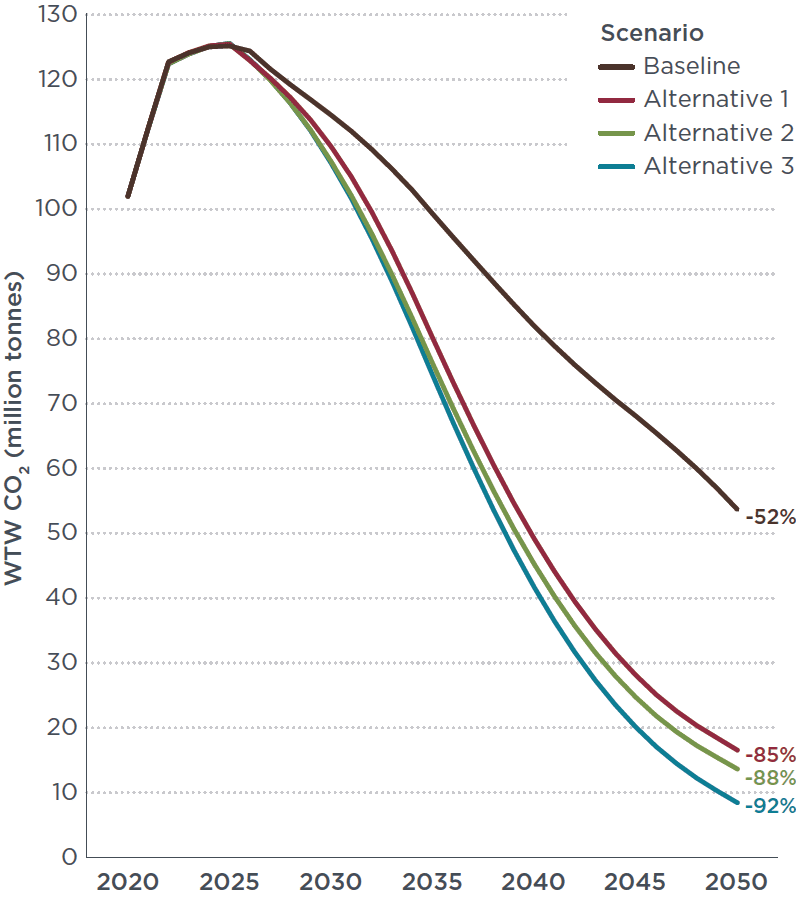Blog
Plug-in hybrids: Friend and foe in Canada’s climate quest
When you last stopped in here at the Canada corner, we were talking about the ways that the Canadian federal government is flexing some zero-emission vehicle (ZEV) policy muscle by extending the national incentive program for ZEV purchases and committing to implementing a ZEV regulation that will require getting to 100% new electric passenger vehicle sales by 2035. This big ZEV push is a centerpiece of Canada’s strategy for achieving greenhouse gas (GHG) emission reductions of 40%–45% by 2030 compared to a 2005 baseline and net zero GHGs by 2050. As us at the ICCT are apt to do, we went searching for all the devils hiding in the details about this transition to ZEVs and what it means for reaching these GHG emissions reduction goals. One of the more interesting findings to come out of the analysis is that the prevalence of plug-in hybrids has an important impact on GHG emission trends over time.
So, what’s the deal with plug-in hybrid electric vehicles (PHEVs)? Cars that plug in are always a good thing, right? Well, it depends. As their name suggests, PHEVs can charge their batteries by plugging into the electrical grid. But, they can also be used as conventional hybrids if the driver chooses not to plug in. Plug-in hybrids use a combination of energy from the electrical grid and the fuel tank, and, for the most part, the more electricity is used, the lower the vehicle’s overall GHG emissions.
Ok, so back to the number crunching. We modeled four different scenarios for how Canada’s fleet of passenger vehicles will evolve out to 2050. The Baseline scenario reflects the growth in ZEV uptake based on provincial and national policies and goals as of April 2022, and three alternative scenarios represent possible regulatory pathways to achieve Canada’s target of 100% electric vehicle sales in 2035. The assumed ZEV sales percentages for new vehicles are shown in the figure below. One important point to keep in mind is the government of Canada assumes that any vehicle with all-electric capability is considered a ZEV. So, for accounting purposes, sales of both PHEVs and fully electric vehicles are included as ZEVs.

Figure 1: Zero-emission vehicle sales share assumptions by scenario for new passenger vehicles in Canada.
As shown, the Baseline gets to 100% ZEV sales by 2050, whereas the three alternative scenarios reach this target 15 years earlier. In Alternative 1, the government achieves 50% ZEV sales by 2030 and 100% ZEV sales by 2035. Alternatives 2 and 3 reflect more ambitious provincial and national targets, resulting in higher ZEV sales prior to 2035 compared to Alternative 1. The main difference between Alternative 2 and Alternative 3 is the split between plug-in hybrid (PHEV) and battery-electric vehicle (BEV) sales. In Alternative 2, we cap the share of PHEVs at 20% starting in 2026, and in Alternative 3, PHEV market share further decreases to zero by 2035.
The well-to-wheel carbon dioxide (CO2) emissions results for all four scenarios are shown in the figure below. Each of the three alternatives have significantly reduced emissions versus the Baseline, and we can also see the marginal benefits of Alternative 2 over Alternative 1, as well as Alternative 3 over Alternative 2.

Figure 2: Well-to-wheel CO2 emissions from Canada’s passenger vehicles fleet between 2020 and 2050. The data labels in 2050 show the percent reduction from 2021 emissions.
So, bottom line, are PHEVs good or bad for Canada? Well, both! In the shorter term, we want to see as many Canadians as possible buying vehicles that can plug in. Whether it’s a PHEV or a fully battery-electric, increasing the percentage of all-electric miles is critically important to bending down the GHG emissions trajectory. This is especially true in Canada, which is home to a very carbon-friendly electrical grid (76% less carbon intensive, on average, compared to the U.S. grid). For example, in 2025, we estimate that the well-to-wheel CO2 emissions of an average PHEV and BEV in Canada are 52% and 82% lower, respectively, than an average conventional vehicle. So, trading a PHEV for an internal combustion vehicle is always a net emissions benefit for Canada. But, over time, as PHEVs and BEVs come to dominate the market, PHEVs’ continued use of fossil fuels becomes increasingly important, as evidenced by the divergent results for Alternatives 2 and 3. In 2050, Alternative 2, where PHEVs make up 20% of EV sales, has 50% higher emissions than Alternative 3, in which PHEVs are forced to sunset by 2035.
Of course, every little bit counts when we’re pushing towards the ultimate goal of net-zero emissions. It’s clear that Canada—and the rest of the world—needs to simultaneously work towards maximizing the number of fully electric vehicles on the road and decarbonizing the electrical grid. But, for now, swapping out fossil fuels for electricity is always a smart play. Canada, PHEVs are our friends! …but we’re going to have to revisit the relationship as we get older.
